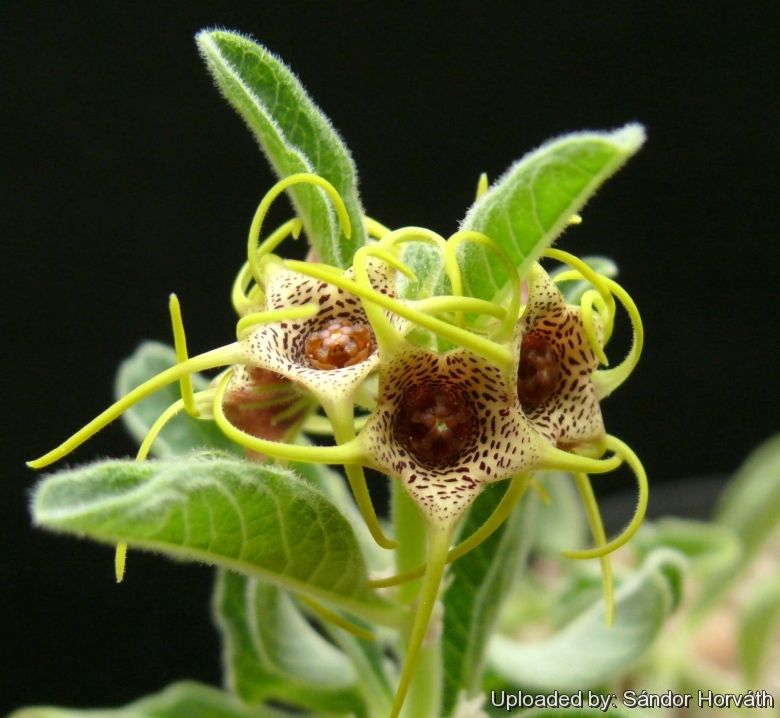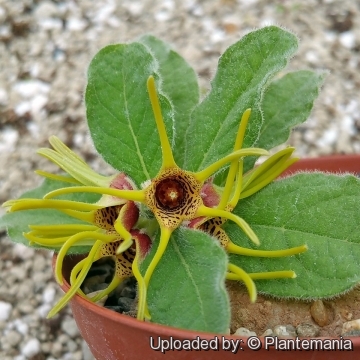
Brachystelma maritae Photo by: Sándor Horváth
Origin and Habitat: Tanzania, Ruvuma and Iringa Provinces.
Habitat and ecology: Brachystelma maritaeSN|32360]]SN|32360]] grows on a rocky ridge in dark soil high in humus. The rainfall in the area is between 800 and 1000 mm per year and falls mainly in summer. At this altitude, the summers are mild, with mist often enveloping the hill.
Synonyms:
Description: Brachystelma maritae is a small-sized perennial herb with a single annual stems to 5 cm long, growing from a slightly depressed tuber (caudex) 5-10 cm in diameter. The leaves are elliptical, short-stalked and densely pubescent. The elegant blooms appears in several flowered groups at the nodes. The strikingly yellow corolla with purple spots distinguish this species. The flowers are strongly scented with a pungent odour. This member of the Asclepiadaceae family was described by Ralph Peckover in 1996
Derivation of specific name: This species was named after Marita Specks, wife of the well know German succulent plant collector and nurserymen Ernst Specks.
Tuber (Caudex): Depressed-globose, to 10 cm in diameter and up to 30 mm thick, often with slightly bowl-shaped central area, underground in the wild, often raised in cultivation.
Stem: Aerial shoot solitary, erect, 3-5 cm long, laxly hispid, 2-3 mm broad at base, finely pubescent, green.
Leaves: Arranged in an alternate or opposite position. Petiole less than 12 mm long and 2 mm in diameter and up to 30 mm thick, green, pubescent. Lamina elliptic to obovate, 20-45 long and 15-20 mm broad, densely pubescent, decreasing in size towards the tip.
Inflorescence: Sessile, lateral, in sets of two opposite umbels of up to 2-10 flowers in each, appearing as a cluster of flowers below the youngest sets of leaves.
Flowers: Sepals lanceolate. 5 mm long, hairy. Pedicels 3-4 mm long, hairy. Corolla outside pubescent, inside glabrous, tube campanulate, 5-6 mm long, 5-7 mm broad, inside yellowish with purple spots. Corolla-lobes linear-lanceolate from a triangular base, 25-30 mm long, somewhat erect, yellow. Corona sessile, yellowish, spotted with purple, 2 mm tall, 3.5 mm across, cup-shaped; Outer corona-lobes lobes pouch-like, margin incised in U-shaped fashion, laterally elongate into 2 white-barbate appendages and fused with the dorsally wing-like broadened Cs Inner corona-lobes linear-lingulate, incumbent on the anthers.
Fruits (follicles): One or two follicles per flower, upright, greyish green, 10 cm, and 4 mm in diameter, glabrous, each containing about 20-24 seeds.
Seed: Brownish black with light brown margin, 9 mm x 3 mm. Coma 20 mm long.
Similar species. B. maritae is distinguished from the very closely related Brachystelma barberae mainly in floral structure.
More...Bibliography: Major references and further lectures
1) Focke Albers, Ulrich Meve “Illustrated Handbook of Succulent Plants: Asclepiadaceae: Asclepiadaceae”, Volume 4 Springer Science & Business Media, 2002
2) Urs Eggli, Leonard E. Newton “Etymological Dictionary of Succulent Plant Names” Springer Science & Business Media, 29 June 2013
3) Ralph Peckovee “An unusually beautiful Brachystelma (Asclepiadaceae): B. maritae, from Tanzania” Cactus and Succulent Journal (U.S.), Vol. 68 (1996) pages 3-5
 Brachystelma maritae Photo by: © Plantemania
Brachystelma maritae Photo by: © PlantemaniaSend a photo of this plant.The gallery now contains thousands of pictures, however it is possible to do even more. We are, of course, seeking photos of species not yet shown in the gallery but not only that, we are also looking for better pictures than those already present.
Read More... Cultivation and Propagation: Brachystelma maritaeSN|32360]]SN|32360]] is hardy in cultivation.
Soil: It grows best in deep earthenware pots in a very draining but rich soil. An error in cultivation may produce unsightly holes in the tuber.
Exposure: In cultivation the plants are usually grown in semi shade, with the tubers wholly or (preferably) partially exposed to prevent scorching and rotting of the roots. When the plants are kept in half a day's sunlight their natural compact habit is maintained, a characteristic feature of most plants in habitat
Hardiness: It should be overwintered in the greenhouse at temperatures over 12°C (avoid letting temperatures drop lower than 5° C).
Water requirements: This plant can take a good deal of water during active growth and should be watered only when not dormant. Keep dryish in winter.
Reproduction: This species can be reproduced by seeds.
More...











